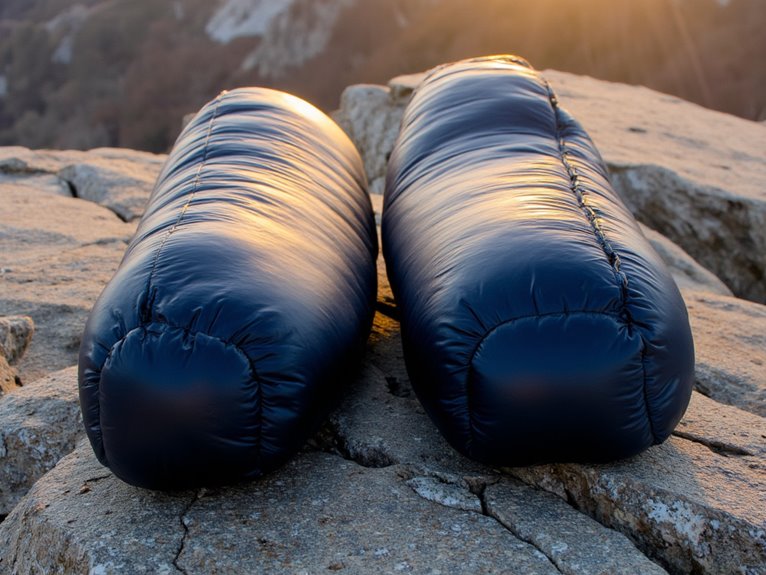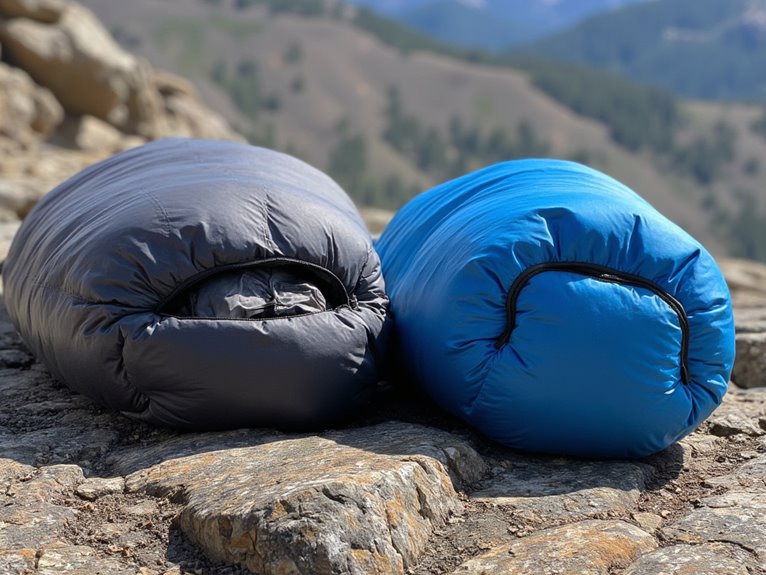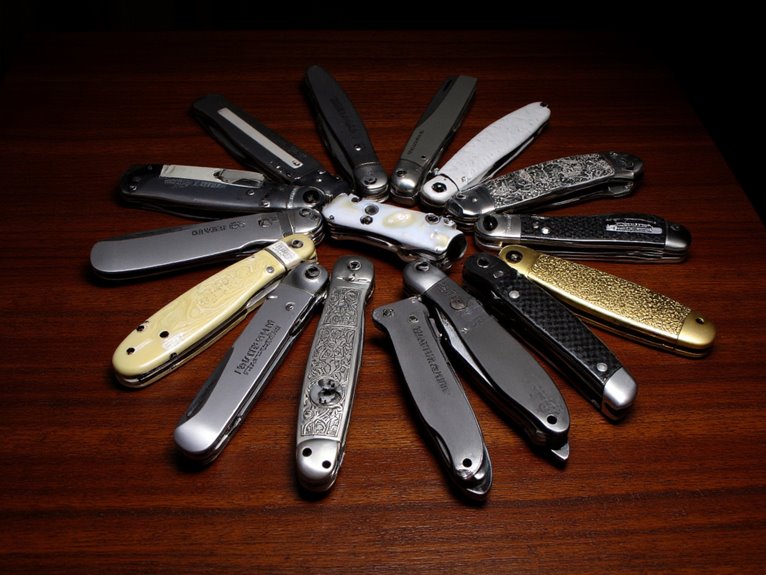Sleeping Bag Fill Power vs. Fill Weight: Balancing Warmth & Packability
Fill power measures how much space one ounce of down occupies (600-900+ cubic inches), while fill weight indicates the total insulation amount in your bag. Higher fill power means better warmth-to-weight efficiency, allowing ultralight backpackers to achieve warmth with less material. However, you’ll still need adequate fill weight for your temperature range—typically 300g for moderate conditions, 500g for cold weather, and 700g+ for extreme expeditions. Understanding these specifications together reveals ideal sleeping bag selection strategies.
We are supported by our audience. When you purchase through links on our site, we may earn an affiliate commission, at no extra cost for you. Learn more. Last update on 9th December 2025 / Images from Amazon Product Advertising API.
Notable Insights
- Fill power measures down’s loft efficiency per ounce, while fill weight determines total insulation material in the bag.
- Higher fill power (800+) provides better warmth-to-weight ratios, allowing lighter bags with equivalent thermal performance.
- Ultralight hikers prioritize high fill power with minimal weight; winter users need both high fill power and increased weight.
- Moderate conditions require ~300g fill weight with 600+ fill power; extreme cold demands 700g+ for adequate warmth.
- Balance depends on activity type: thru-hikers favor packability, while basecamp users can accept heavier bags for warmth.
Understanding Fill Power and Its Impact on Insulation Performance
When you’re evaluating sleeping bag insulation, fill power stands as the most critical metric for understanding down performance.
Fill power measures how much space one ounce of down occupies when lofted, expressed in cubic inches. Higher numbers indicate greater loft and superior insulation efficiency.
Higher fill power equals better insulation efficiency, as one ounce of down occupies more cubic inches when properly lofted.
The measurement process involves placing treated down into a calibrated tube under controlled temperature and humidity conditions. A standardized weight compresses the down for a specific duration, determining its loft capacity.
Fill power directly correlates with insulation performance. Down with 800 fill power traps considerably more air per ounce than 600 fill power down.
This increased air retention creates better thermal barriers while requiring less material. Consequently, you’ll achieve superior warmth-to-weight ratios with higher fill power options, making them ideal for ultralight backpacking applications.
Premium down insulation achieves 800+ fill power ratings for maximum loft and warmth retention in high-performance sleeping bags.
Fill Weight Fundamentals: How Total Insulation Affects Warmth
Fill power tells only half the story of a sleeping bag’s thermal performance—the other half lies in fill weight, which measures the total amount of down packed inside your bag. This metric directly determines your bag’s warmth capacity. More down equals more trapped air, which translates to better insulation efficiency.
Down distribution follows a strategic pattern. Manufacturers typically place 55% of total fill in the top layer where heat loss occurs most rapidly. This uneven allocation maximizes thermal retention where you need it most.
| Fill Weight | Temperature Rating | Typical Use | Pack Size Impact |
|---|---|---|---|
| 16-20 oz | 40°F to 30°F | Summer camping | Minimal |
| 24-28 oz | 20°F to 10°F | Three-season | Moderate |
| 32-40 oz | 0°F to -10°F | Winter conditions | Significant |
| 45+ oz | Below -20°F | Extreme cold | Maximum |
Higher fill weights create warmer bags but reduce packability. However, down sleeping bags still maintain a significant weight advantage over synthetic alternatives, typically weighing 20-30% less than synthetic bags at comparable temperature ratings.
Temperature Ratings vs. Insulation Specifications: What Really Matters
Understanding temperature ratings requires more than glancing at the big number on a sleeping bag’s label—you need to decode how manufacturers test these ratings and what they actually mean for your comfort in the field.
EN/ISO standards provide standardized lab testing that measures comfort, lower limit, and extreme temperatures for both men and women. These ratings assume you’re using a sleeping pad with an R-value around 5.38. The comfort rating represents the safest threshold for cold sleepers, while the lower limit indicates the coldest temperature a typical man can sleep comfortably.
However, lab conditions don’t account for real-world variables.
Temperature differences between testing environments and actual campsites affect performance markedly. Different insulation types—whether 800-fill-power down or synthetic alternatives—respond uniquely to humidity, compression, and temperature fluctuations that ratings can’t predict. Women typically require sleeping bags with temperature ratings 10-15 degrees warmer than standard ratings to achieve the same comfort level as men.
Optimizing Warmth-to-Weight Ratios for Different Outdoor Activities

While temperature ratings grab attention on sleeping bag labels, the real performance story lies in how manufacturers balance fill power and fill weight to optimize warmth-to-weight ratios for your specific outdoor pursuits.
Your backpacking strategies should dictate your fill power choices. Ultralight hikers need 800+ fill power down with minimal fill weight for maximum packability.
Smart gear selection starts with knowing your hiking style—ultralight adventurers demand maximum loft with minimum weight for peak packability.
Three-season backpackers can balance 700-800 fill power with moderate fill weight for versatile performance.
Winter mountaineers require 850-900+ fill power plus increased fill weight to combat extreme conditions.
Warmth optimization varies by activity type. Thru-hikers prioritize compressibility and lightweight construction.
Basecamp camping allows heavier bags since packability matters less.
Paddlers need water-resistant shells with efficient fill distribution for moisture management and space efficiency.
Quality ripstop nylon shells with 400T fabric construction provide essential durability while maintaining the weight savings that serious backpackers demand.
Selecting the Right Balance Based on Your Adventure Requirements
How do you determine the ideal balance between fill power and fill weight for your specific adventure? Start by analyzing your expected temperature range and activity type.
For moderate conditions (5°C to 10°C), target 300g fill weight with 600+ fill power for optimal insulation efficiency. Cold expeditions demand 500g fill weight, while extreme conditions require 700g or more.
Calculate your needs by dividing required loft volume by fill power rating. Adventure conditions dictate whether you’ll prioritize packability or maximum warmth retention.
Ultralight backpackers benefit from high fill power with minimal weight, while expedition hikers need substantial fill weight for sustained thermal performance.
Always verify EN or ISO temperature ratings rather than relying solely on specifications.
Consider your sleeping style, bag shape, and layering system when making final selections.
Remember that comfort ratings typically require adding 25-30°F to manufacturer specifications to ensure true warmth levels during your outdoor adventures.




